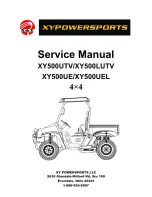
HYDRAULIC AND PARK BRAKE SYSTEMS
Brake Shoe Removal
2001 Pioneer 1200 Gasoline Vehicle Maintenance and Service Manual Page 6-9
6
4.2. Using a torque wrench and hydraulic brake adjuster (CCI 102169401), gently rotate the adjuster
bolt in order to increase the clearance between the brake shoe lining and the brake shoe drum
(Figure 6-3, Page 6-8).
5. Repeat steps 1 through 4 for the opposite rear wheel if necessary.
BRAKE SHOE REMOVAL
Read WARNING on page 6-1.
∆ WARNING
• If at any point in this procedure the hydraulic system is opened, the brakes must be bled after
the correct reinstallation of the brake components. Failure to bleed the brakes could result in
decreased braking performance due to air being trapped in the hydraulic system. Use only
DOT 5 brake fluid. See Bleeding the Hydraulic Brake System on page 6-29.
1. Brake drum removal is necessary prior to removing the brake shoes. See Brake Drum Removal on
2. Remove the rear axle to remove rear brake shoes. To remove the front brake shoes, proceed to step 3.
2.1. Using 90° internal snap ring pliers (.090 tip) (CCI 1012560), remove internal retaining ring from
axle tube (Figure 6-4, Page 6-9).
2.2. Carefully pull the axle shaft straight out of the axle tube.
2.3. Repeat steps 2.1 and 2.2 for the opposite rear wheel if necessary.
3. Using pliers or a brake tool, rotate the cup and spring assembly 90° and remove the cup and spring from
each brake shoe (Figure 6-5, Page 6-10).
NOTE: The brake shoes are under spring pressure and can release suddenly when cup and spring assem-
blies are removed.
4. Grasp both brake shoes and pull them, with the springs, out of brake cluster assembly (Figure 6-6,
Figure 6-4 Remove Axle Retaining Ring
















































